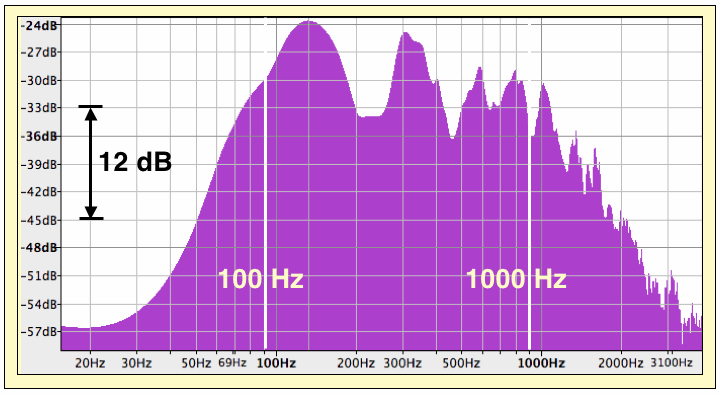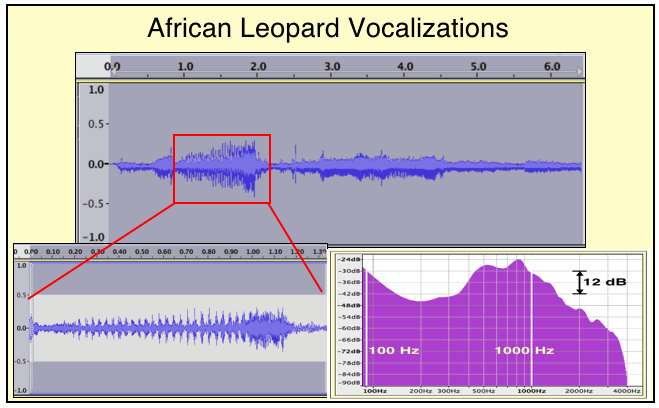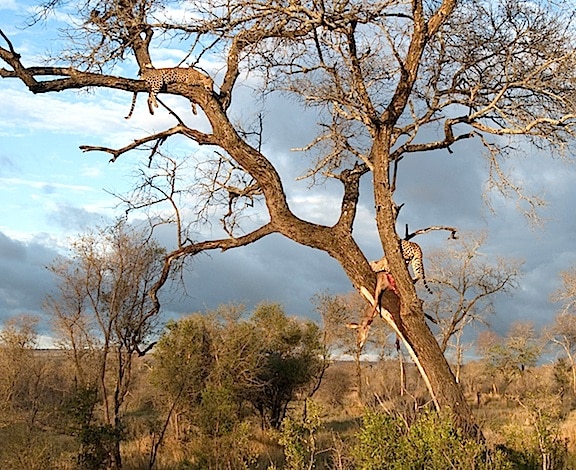Leopard Communication
The Leopard is the largest spotted cat in Africa, and a powerful symbol of the wild places of earth: it is solitary, beautiful, graceful, strong, agile, and cunning. Leopards are heavier and more strongly built than cheetahs, but still one third the size of lions. Their spots are dark rosettes with a hollow center, all on a tan background. Leopards hunt at night, generally in dense vegetation; preferring to pounce on their prey, rather than chase after them. They stalk slowly through grass or bushes, and attack when only a few feet away.
Although smaller than a lion, the sleuth-like leopard is often more feared. It is considered fiercer, braver and very intelligent: a perfectly streamlined killing machine with exceptional hearing, good eyesight and sensitive, extra-long whiskers that help it avoid obstacles in the dark. The body is compactly built and cat-like, the head massive, and the strong, very sharp, curved claws are fully retractile. The ‘dew claw,’ which is the claw of the first digit on the front feet, is used to hold large prey. The leopard is also a remarkable athlete, capable not only of swimming across rivers, but also of leaping onto rocks up to 10 feet high, carrying prey even heavier than itself, as well as hoisting heavy carcasses into the branches of trees. Leopards are adept climbers: they scale even smooth barked trees with ease, and move with confidence among swaying branches.
Leopards are usually nocturnal, although they are occasionally active by day, and can sometimes be seen during the day lying up in a tree. They shelter during the heat of the day, either in trees, caves, or in the shade of rocks; in arid regions they often crawl into disused aardvark burrows for shade. Trees and rocks double as vantage points from which they survey their hunting terrain, as well as avoiding other predators such as lions or spotted hyenas, or, their most dangerous competitor, another leopard.
Behavior
By day, leopards often lounge and nap in large trees with sloping branches. After making a kill, they will drag it up into a convenient tree for protection, presumably from lions or hyenas that might steal their catch. A leopard will then return to the tree for several days to feed and rest. The classic pose of a leopard is feet dangling from a large Acacia tree, fast asleep with its kill draped over branches in front of it. Unlike lions, leopards are solitary animals throughout their lives. They establish and defend territories, meeting only to mate. Despite these avoidance mechanisms that have been developed, fighting among male leopards is fairly common, and can be severe.
The home ranges of female leopards are smaller than those of the males, and male home ranges may overlap with that of more than one female. In areas of prey abundance, where there is a high density of leopards, the territories of males may overlap considerably, and in such cases, the leopards usually actively avoid contact, using the ‘common area’ at different times. The size of the territory depends on the habitat, and ultimately on the amount of food available within that habitat and particular area. Leopards are territorial, and defend their territories against individuals of the same sex. Males and females mark their territories by spraying urine and by leaving warning claw marks on tree trunks at the edges of their territories.
Communication
African leopards are normally silent, so less has been written about their communication than about that of elephants and, to a lesser degree, lions. So, how do their communications relate to the “Sounds of Africa?” Like most cats, they communicate by various smells, scratches, body language, and sounds. The smells come from urine scent glands on their heads, chins, between their toes, and at the base of their tails. Every time leopards rub against something, they transfer special scent for others to smell, marking their territory.
The scent left by a female will tell a male passing through her range if she is ready to mate. They use their ears to signal their mood and twitch their tails to show if they are excited. Scratching allows them to clean their claws and stretch their limbs. Their most characteristic vocalization is a hoarse, rasping cough (called a roar by some), repeated at intervals, which has been likened to sawing through a rough piece of wood. Once heard, this sound is not easily forgotten. This sound can define their territories or signal that they are alarmed. When it’s defining territory, the sound will be answered by another leopard, if one’s in the area, and will then be repeated between the two as they move.
Leopards have individualistic, distinctive calls, and it is probably advantageous for solitary animals such as leopards to recognize one another from a distance, via vocalizations, because they generally avoid each other. Two territorial males will often grunt and growl at each other, and female leopards call when they are in estrus. When threatened, or when fighting an enemy, the leopard will hiss, spit, growl, snarl, and make rasping yowls. Leopards have also been known to purr during feeding, and females purr and meow, much as domestic cats do, but normally only between mother and cubs.
Other than such anecdotal comments and some tape recordings of the sounds, there is little written about the levels, range, and spectrographic analyses of leopard vocalizations, at least from what this author could find. Of all cats, only the four larger species, lion, tiger, jaguar, and leopard are able to roar. However, in the case of the leopard, and possibly the jaguar, the term “roar” is loosely used. What is considered a leopard’s best “roar,” as provided via recordings, is evaluated in Figure 1. This seven-second waveform shows numerous interruptions, more suggesting of the “sawing” or “growling” noise that often describes the leopard’s communications. This “roar” waveform shows characteristics of human speech communication.

Figure 1. Waveform and audio of seven seconds of a leopard’s “roar.” Vocalization waveforms longer than this tend to show less force, and have less dynamic range.
Click here to listen to the leopard (opens a new tab or window. You will have to re-click on “The Sounds of Africa – Leopard, to return to the blog) – Leopard Roar
Figure 2 shows the spectrum of the “roar” in Figure 1. It shows peak energy around 150 Hz, energy down to about 50 Hz, and extending upward in frequency to about 3000 Hz. This vocalization frequency range would seem to be excellent for carrying the signal over long distances.

Figure 2. Spectrum of the leopard roar of Figure 1. The frequency range of vocalization is fairly narrow, and of low frequency.
A vocalization sample taken from the young leopard in the tree in the accompanying video is shown in Figure 3. The waveform shows the vocalization in its entirety, but the intent was to look at just the strongest portion, and onset of the leopard vocal activity – that shown in the red rectangle.
When expanded in time (lower left), the vocal fold activity can be clearly seen. And, although not shown here, it carries through the rest of the leopard’s cry. The lower right shows the spectrum of that section of the leopard vocalization.

Figure 3. Vocalization of the young male leopard in the tree of the accompanying video. Just a short sample was taken of the initial sound, and then expanded, to show the vocal cord modulations (from rectangular box to lower left), and then the spectrum of that portion of the vocalization (lower right).
Hearing
Leopards are said to have excellent hearing, but one can spend a long time attempting to find any specific data related to this – so, we will just have to assume that this is true. Assumptions come from studies on cats of smaller species, finding that they can hear sounds up to about 65,000 Hz (ultrasound), but the high-frequency hearing of leopards seems not to have been investigated. The African leopard is said to be able to hear small animals rustling through the grass or even moving around in their burrows underground.
Leopards are believed to have excellent hearing, although specific data on their abilities is scarce. They are thought to be able to detect a wide range of sounds, including ultrasonic frequencies, aiding in their ability to locate prey and navigate their environment.
Their earflaps supposedly help concentrate sound waves deep into each ear. Some descriptions related to leopards say they can hear five times more sounds than humans, even the ultrasonic squeaks made by mice. However, what does “five times more” sounds mean: quantity, range? And, how might this have been determined?
My armchair logic suggests that their range of hearing relates primarily to the sounds necessary for them to hear and respond to in their environment – other prey, or warning sounds. Large cats, at least lions, hear sounds that are infrasonic (too low for human ears), and the lion roar has an infrasonic component. Because leopards and lions are not budding friends, it seems reasonable that the leopard has infrasonic hearing as well to be able to monitor lion sounds. The leopard uses other senses as well to succeed in their habitat. Their eyesight is excellent, and while adapted for night vision, they can also see well in daylight. Their long, stiff whiskers have very sensitive nerve endings at their roots, with some causing the leopard to blink for protection or to help feel their way in the dark, while others are used to help judge how far away objects are. While the nose is very sensitive, smell seems not to be used for hunting purposes.
Wayne Staab, PhD, is an internationally recognized authority in hearing aids. As President of Dr. Wayne J. Staab and Associates, he is engaged in consulting, research, development, manufacturing, education, and marketing projects related to hearing. His professional career has included University teaching, hearing clinic work, hearing aid company management and sales, and extensive work with engineering in developing and bringing new technology and products to the discipline of hearing. This varied background allows him to couple manufacturing and business with the science of acoustics to bring innovative developments and insights to our discipline. Dr. Staab has authored numerous books, chapters, and articles related to hearing aids and their fitting, and is an internationally-requested presenter. He is a past President and past Executive Director of the American Auditory Society and a retired Fellow of the International Collegium of Rehabilitative Audiology.
**this piece has been updated for clarity. It originally published on January 6, 2013








